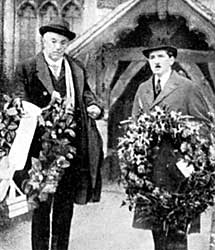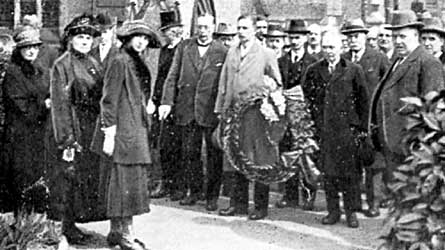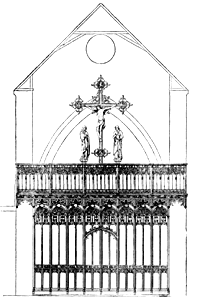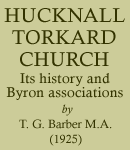Twenty-eight years passed. The vault was opened once again, and on December 3, 1852, there was lowered into it the body of Augusta Ada, the Poet's daughter. She died at the same age as her father, and by her expressed desire was buried by his side. This is the record of her burial:—
1852.—Augusta Ada, Countess of Lovelace, 69, Cumberland Place, London, buried December 3, age 36 years, by Curtis Jackson.

The Entry of the Burial of Augusta Ada, the Poet's daughter, 1852 A.D.
The tragedy of Missolonghi looms so largely in our minds that we are apt to overlook the fact that Byron's ardent and unceasing championship of man's freedom has stirred the strongest hearts, and fostered the noblest impulses, in almost every country where man has had to struggle against the fetters of tyranny, or of tradition. That final sacrifice on the Gulf of Patras stands, as it were, the keystone to the arch he built for the whole world to see. No race—no aspirations—for which he has not a thought, expressed in words that plead, words that teach, words that shatter apathy and louse the best!
Of Bonnivard he wrote:—
"Chillon, thy castle is a holy place,
And thy cold floor an altar; for 'twas trod
Until his very steps have left a trace. . .
. . .By Bonnivard. Max none those marks efface,
For they appeal from tyranny to God."
And did he vaguely sense Missolonghi when he anticipated a Victor Emmanuel and a Garibaldi, in words that endear him to every true Italian today? :—
"It is no great matter, supposing that Italy could be liberated, who or what is sacrificed. It is a grand object— the very poetry of politics. Only think—a free Italy!!! Why\, there has been nothing like it since the days of Augustus."
And this obsession—this steady conviction that example outruns precept—that actual sacrifice must be made—breaks through, again and again, during his sojourn in Greece, and in few passages finer than Salamis.
"Must we but weep o'er days more blest?
Must we but blush? Our fathers bled.
Earth render back from out thy breast
A remnant of our Spartan dead—
Of the three hundred, grant but three
To make a new Thermopylae."
To uplift men by precept alone is noble work; to rouse men to deeds by force of prayer is genius; but to die, that both prayer and precept may achieve consummation, is little short of divine. Surely a better epitaph to such a life would be hard to find than is contained in those immortal lines written at a similar crisis, and in a similar cause, by one who undoubtedly owed much to Byron's Promethean philanthropy (in its world-wide sense), and to the courageous expression of that philanthropy, in thought, in written word, and in final bitter end.
"In the beauty of the lilies Christ was born across the sea, With a glory in His bosom that transfigures you and me. As HE died to make men holy, let US die to make men free. Our God is marching on."
Our story is told—the story of the Church of Hucknall Torkard, and its association through the centuries with the Byron family. Hucknall Torkard is no longer the little hamlet in the forest clearing, but a town of 17,000 population, with its mines and its factories. Hucknall Torkard Church is no longer a small and simple structure, but an edifice of size and beauty, with its Gothic arches, its richly coloured windows, and its elaborate mural decorations. Thousands of pilgrims from the uttermost bounds of earth pass through its doors to admire its beauty, and to pay tribute to the memory of the most illustrious member of that family whose story has been briefly told within these pages.
On April 19, 1924, the Centenary of the Poet's death, a Memorial Service was arranged. The ancient Church was filled to overflowing. People came from far and near to offer a tribute of praise for his gift of genius and his heroic sacrifice in the cause of liberty.
 |
 |
| Major E. Atkin, Secretary of the Byron Society, and Mr. Charles Fraser, of Newstead Abbey, lay wreaths on the Poet's Tomb, April 19, 1924. |
The Hucknall Torkard Centenary Committee entering the Church for the Memorial Service, April 19, 1924. |
It was after this inspiring service that many expressed the desire to see in the Church, where his body rests, some memorial to mark the 100th anniversary of his death. The writer of this little book was asked to move in the matter, and now a most earnest appeal, supported by a widely representative committee under distinguished patronage, is made to the reader to give interest and financial help to the Lord Byron International Memorial Fund, which has been established for the purpose of:—

The Proposed Memorial Screen to be erected in Hucknall Torkard Church.
(1) Erecting a beautiful carved oak screen, coloured after the mediaeval tradition, bearing on its panels coats of arms associated with Lord Byron, and on the rail a simple inscription.
(2) Founding travelling scholarships in the name of Byron, to be awarded irrespective of nationality.
The centenary of his death emphasised the omission of any fitting tribute to this genius of worldwide fame, whose literary achievements are the admiration of people of every country, and whose last days were given to the cause of liberty.
